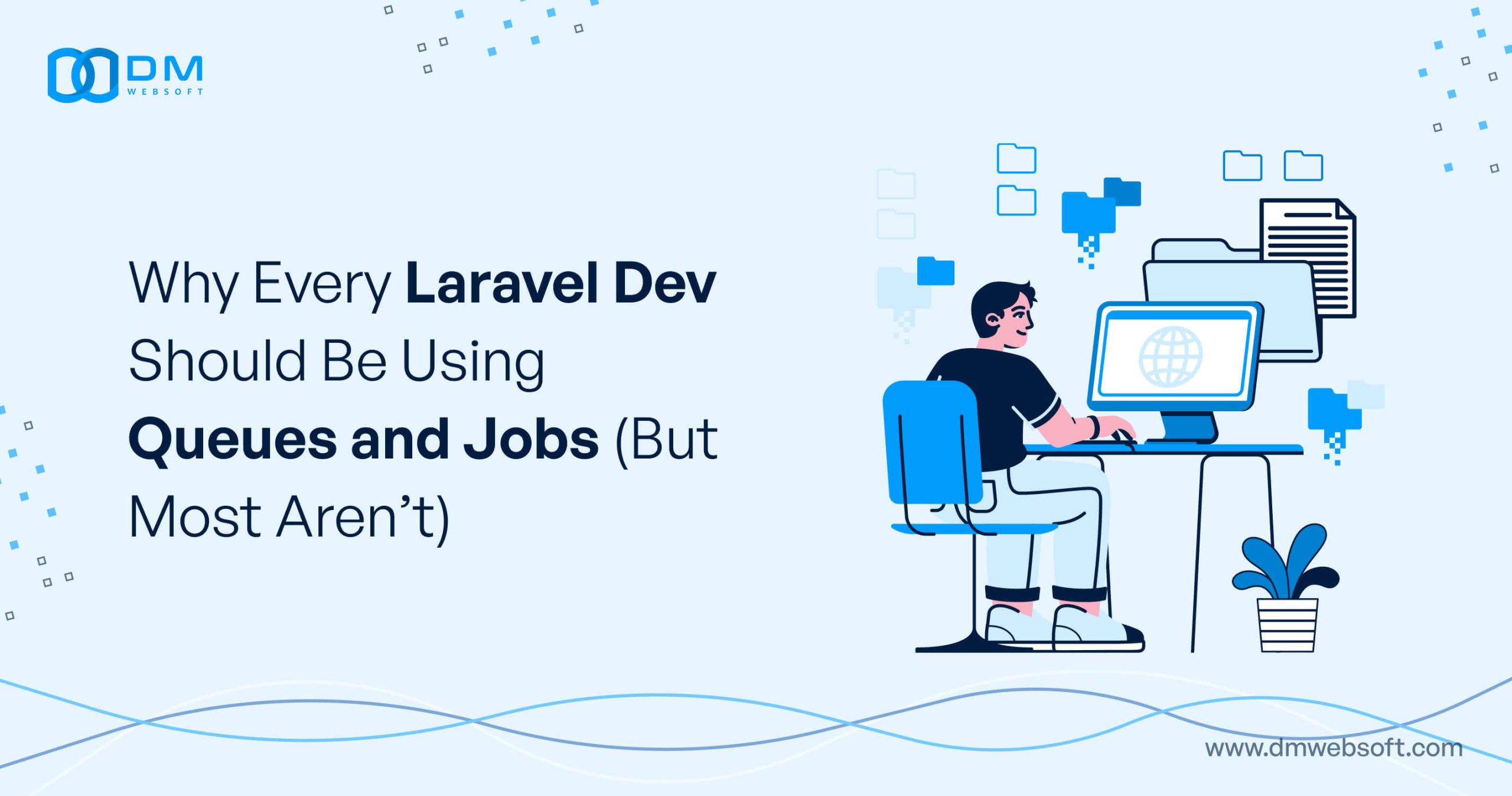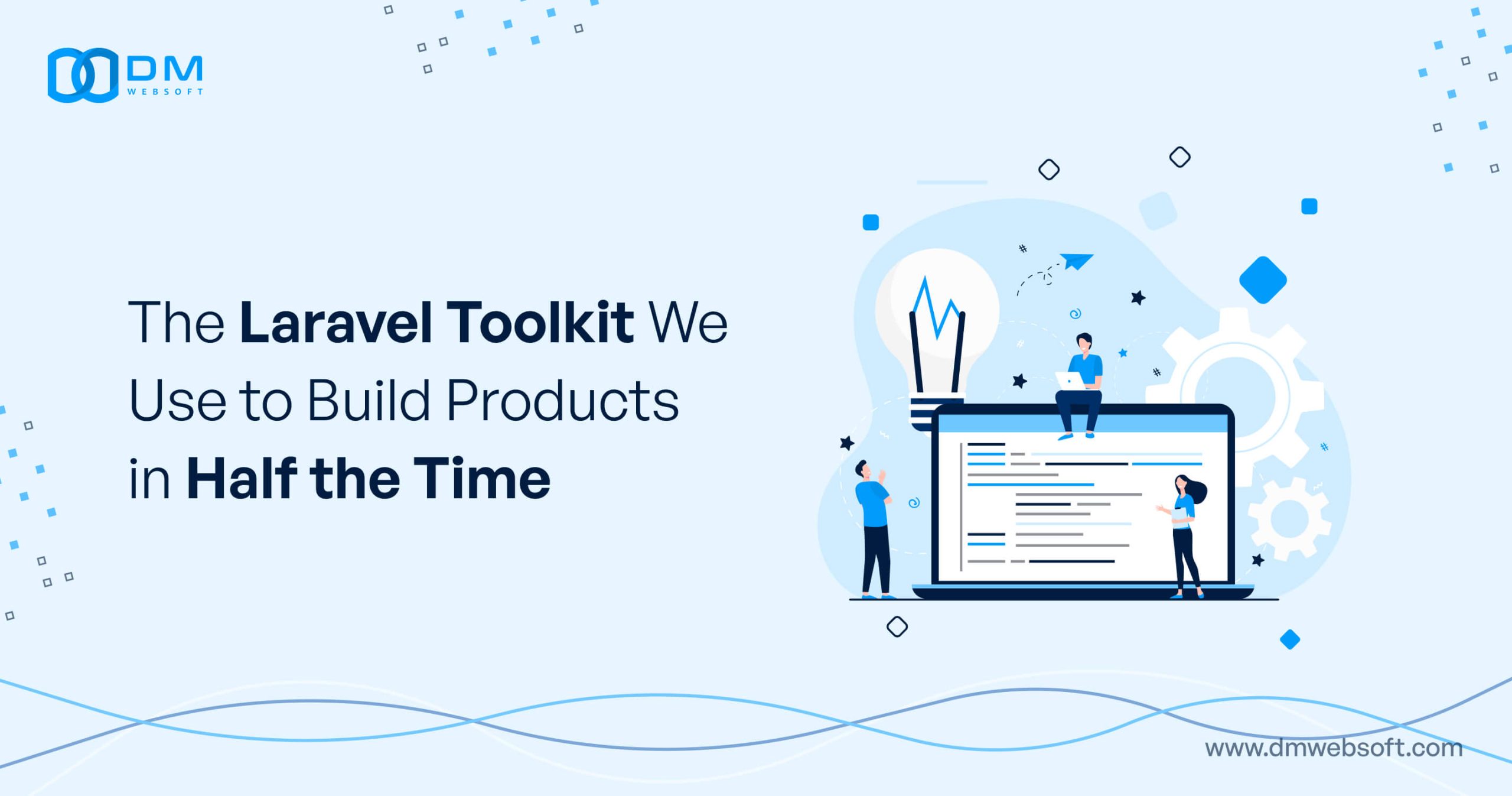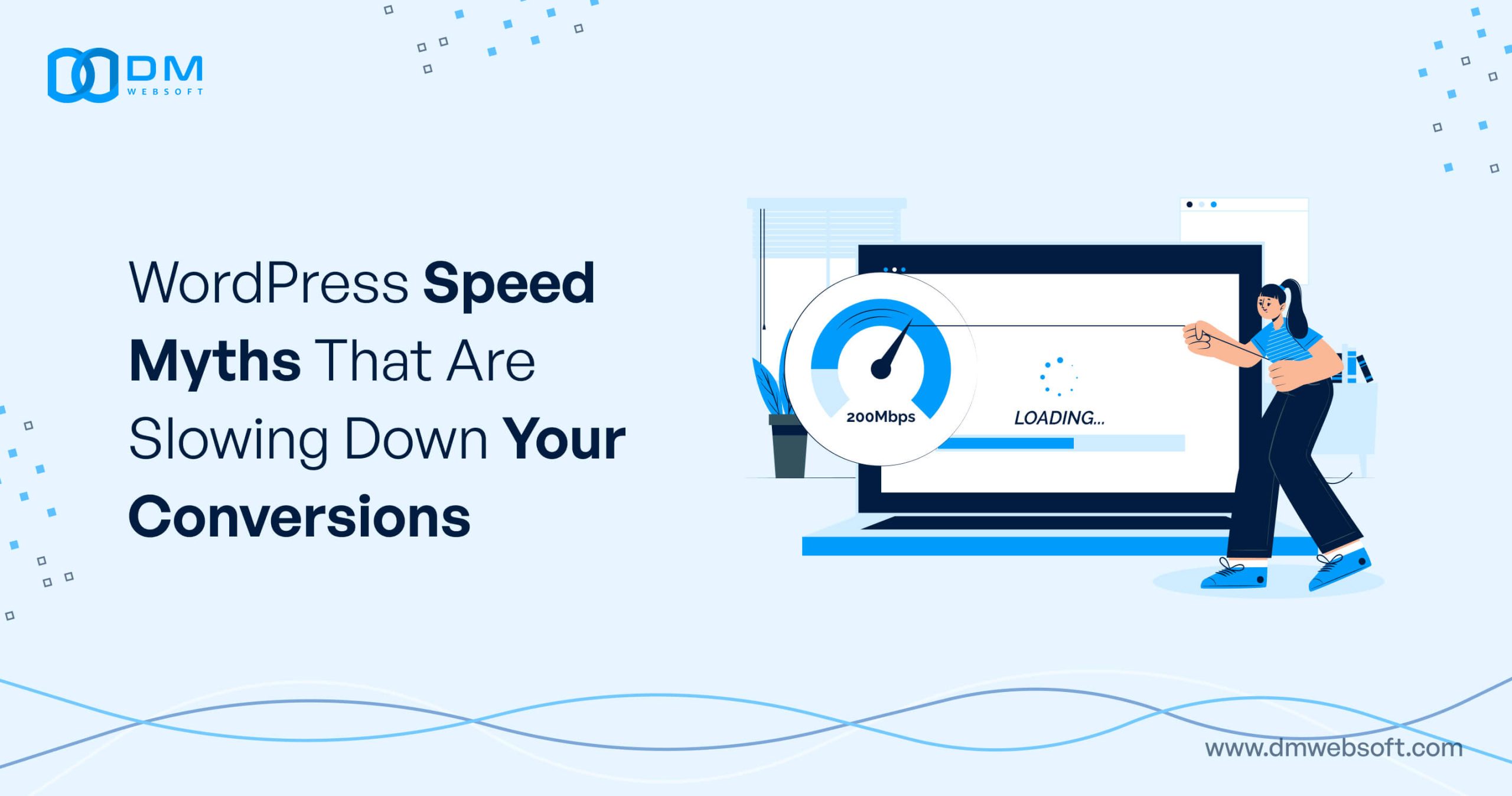DM WebSoft LLP exceeded our expectations! Their seasoned team of experts delivered a website that perfectly captures our brand essence. Their 15+ years of experience truly shine through in their exceptional web development skills.
Secure Your MERN Stack Application: Security Best Practices

TABLE OF CONTENT
Get in Touch
Introduction
Security, in present-day web applications, has grown to be a critical issue. Security of every application is one of the serious concerns nowadays, considering the maturity of threats. It further becomes challenging since the development of applications involves the adoption of a very popular framework, MERN. MERN, being a combination used to develop modern, dynamic web applications, involves a stack of MongoDB, Express.js, React, and Node.js.
At DM WebSoft LLP, we surely know how painful and intricate it is to develop and secure MERN stack applications. Our strong experience in the security of web applications lets us offer other detailed solutions to guard against possible vulnerabilities and threats to the application. In this blog, we take you through back-to-front best practices for securing your MERN stack application in order for it to be guarded against security threats.
Why does security matter for MERN stack applications? The answer has to do with the architecture of a stack. Each of MongoDB, Express.js, React, and Node.js, while playing a really critical role in the application’s functionality, also introduces its own vulnerabilities.
Whether you are looking to protect your MongoDB database from injection attacks or trying to secure your Express.js server from unauthorized access, whether you are trying to apply best practices for React to avoid cross-site scripting (XSS) or trying to harden your Node.js environment with respect to a variety of exploits, a comprehensive approach to security is paramount.
By the end of the balance detailed handbook, you would already have insight into really applying security effectively on your MERN stack application. These have been listed with how an association with a professional service provider like DM WebSoft LLP can help actualize and maintain the goal of an assured application environment. Our team of experts is ardent about ensuring your web applications are at the best-possible level of security that would enable you to be a leader in providing best-in-class products and services to your customers.
Understanding the MERN Stack and Its Security Importance
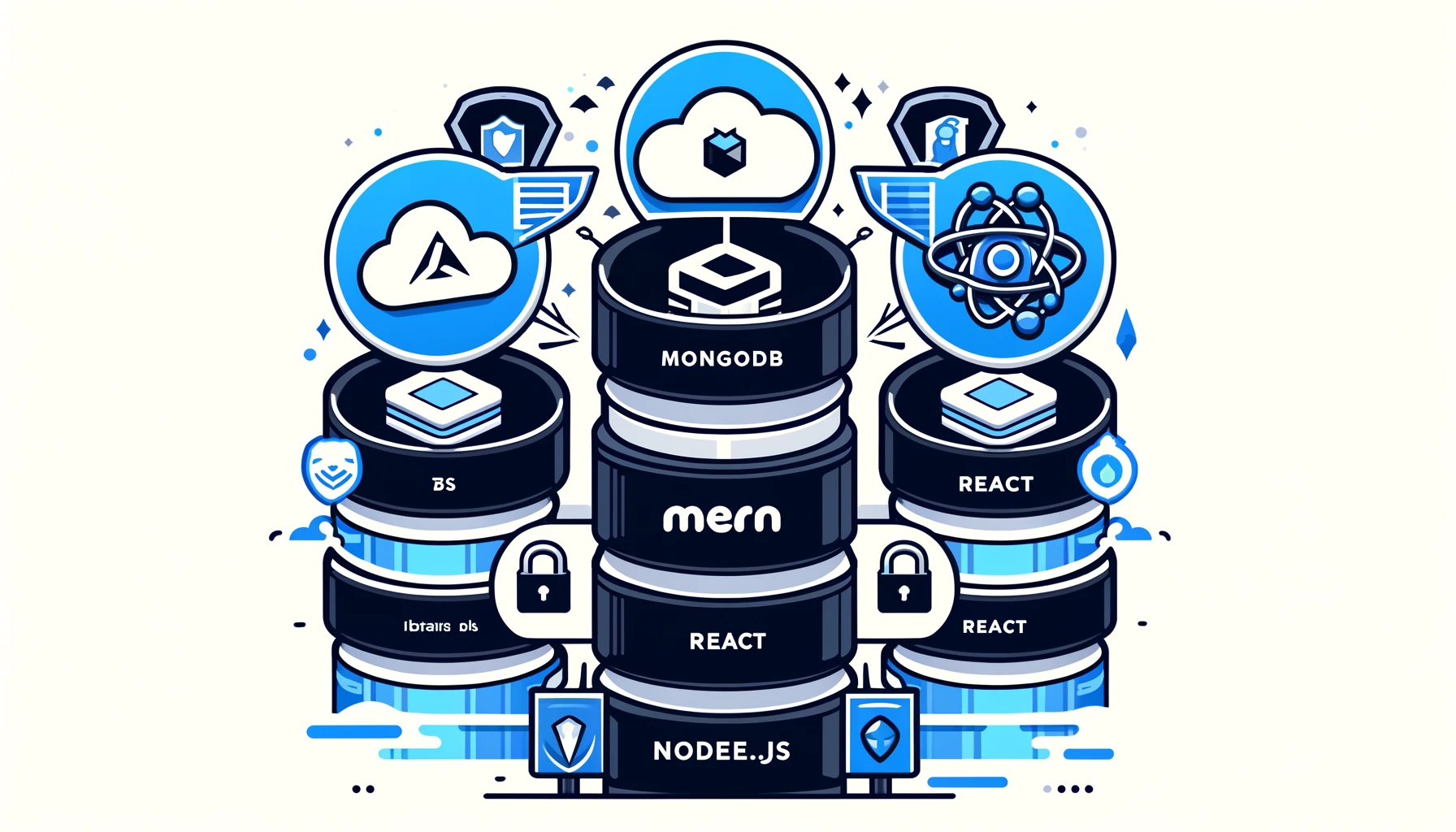
Understanding of the MERN stack requires appreciation of the full meaning of the MERN stack. MERN is an acronym that stands for MongoDB, Express.js, React, and Node.js. The MERN stack is a potent stack of four technologies bonding MongoDB, Express.js, React, and Node.js, and collectively builds full-stack JavaScript solutions to make robust, scalable web applications.
One can say that MongoDB is a NoSQL database known for its flexibility and scalability. Since data storage is in JSON-like documents, it can easily be integrated with any application that uses JavaScript. But sometimes its very schema-less nature can lead to vulnerabilities if it is not properly secured.
Express.js It’s a web application framework for Node.js. It helps you create powerful APIs and web servers. Even though Express is embedded with ample safety features, developers must still be cautious and meticulously tune them to elude common pitfalls such as injection attacks and better error handling.
React is a library on Facebook described as a front-end tool for any developer. A developer can build dynamic, high-speed interfaces flexibly and efficiently. While React itself is known for security, improper generation opens up many vulnerabilities for web applications, such as cross-site scripting (XSS).
Node.js is a runtime environment allowing one to execute server-side scripts with JavaScript. The most important characteristic of the language, which makes it truly good for scalable applications, is its non-blocking, event-driven architecture. However, wide use and high availability of third-party modules often come with the cost of extra security risks unless the dependencies are managed carefully.
As these three technologies are interlinked, a security breach in any one of them actually compromises the whole application. Therefore, it is important to know and implement best practices for security in the MERN stack to secure the application with data.
We at DM WebSoft LLP are dedicated to safeguarding MERN stack applications. Our specialists take care to strengthen each layer of your application against potential threats. Our team follows a rigorous practice of in-depth security audits, strong authentication mechanisms, effective monitoring through the best-in-class tools, and continuous protection of your applications.
Why security is so important in MERN stack applications: Suppose a vulnerability in your MongoDB database allows unauthorized access to your sensitive user data. And an insecure Express.js server may be vulnerable to injection attacks, risking the integrity of your backend.
Poor implementation of React components can lead to XSS attacks, allowing malicious script execution on the client side by the attacker. Poor or bad security practices in Node.js would let in a number of exploits, putting your whole application at risk.
All these aforementioned risks can be easily mitigated by following security best practices and using the expertise of a trusted partner like DM WebSoft LLP for MERN stack application security. With a top-down approach to web application security, from secure coding guidelines to advanced monitoring solutions, you get peace of mind to be able to pay all your attention to delivering exceptional user experiences.
We are going to explore the common vulnerabilities of MERN stack applications and follow actionable strategies to address them in the upcoming sections. Whether you are an experienced developer or a greenhorn who has just decided to work with the MERN stack, this guide should help you be better prepared with an understanding and tools to protect your app from evolving security threats.
Typical Security Issues of MERN Stack Apps

Armed with the knowledge of common security weaknesses that compromise your MERN stack applications, you are enabled to build security. Knowing vulnerability is the first step towards mitigation of potential threats and ensuring safety of data and users.
1. Injection Attacks
SQL injection and NoSQL injection are two of the most common threats to web applications in regard to injection attacks. These are injected in web applications when untrusted data is sent as part of a command or query to a particular interpreter that tricks it into executing unintended commands or accessing unauthorized data. Among MERN stack applications exposed to the maximum level in databases is MongoDB, which easily could be under the threat of NoSQL injection in case proper input validation and use of parameter queries are not done.
2. Cross-Site Scripting (XSS)
A cross-site scripting (XSS) attack is an attack in which a malicious party injects malefic scripts into content that is delivered to other users. This will result in various malefic activities, such as session hijacking, defacing, and spewing out malware. React applications are vulnerable to XSS whenever user input is rendered without any sanitization or escaping.
3. Cross-Site Request Forgery (CSRF)
Cross-Site Request Forgery is one such attack in which the victim is tricked into generating an evil request. It is based on trust. An application can trust a user’s browser. One can effectively turn a user’s own browser against that user for an attack against a web application in which that user is currently authenticated. Express.js provides a way to properly implement the CSRF token, hence reducing this risk.
4. Broken Authentication and Session Management
Both authentication and session management are of prime importance in web application security. Incorrectly implemented, such mechanisms present a prime attack vector for attackers to gain illicit access to sensitive information or functionality. Most common types of vulnerabilities are weak password policies, not implementing MFA, and insecure session handling. Strong authentication practices have to be maintained in a Node.js and Express.js application or in any MERN stack application to guarantee security.
5. Insecure Dependencies
Oftentimes, a lot of third-party modules are being used in Node.js applications. Those help increase the speed of development but tend to bring with them a lot of security vulnerabilities if not managed effectively. Insecure dependencies might lead to various kinds of exploits, data breaches, and security issues in general. Dependencies should be regularly updated using tools like npm audit for vulnerability identification and the fixing of those in the third-party packages.
Do expect that to be a part of our job: to help point out and mitigate those common vulnerabilities. Our experts will conduct a thorough security audit to find potential weaknesses within your MERN stack applications. Our recommendations and implementation best practices help protect your applications from these types of threats.
Understand these common vulnerabilities for proactive defensive measures concerning securing an application built on a MERN stack. The next section will walk you through some best practices in securing the backend of a MERN stack application, which ensures safety regarding the server-side code and databases.
Best practices for securing the back-end of a MERN stack application
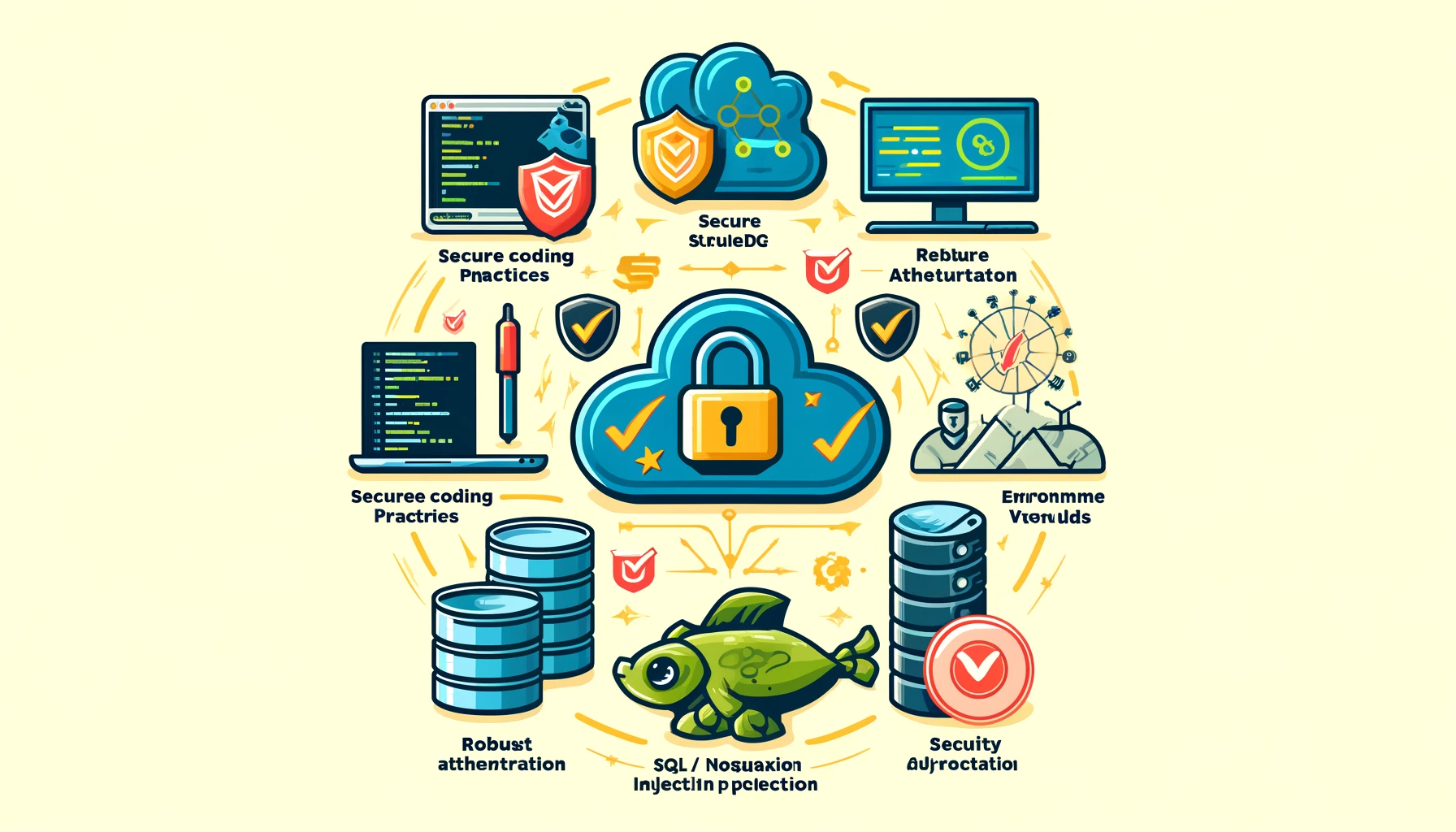
Security on the back end in your MERN stack application is crucial as it protects your data and server-side logic from malicious attackers. Below are some best practices for securing your back-end components:
- Secure Coding Practices: Secure coding has to be in practice to make a MERN stack application non-vulnerable. By that, it means validating and sanitizing all inputs provided by users—no exception—as well as not using deprecated functions like eval(). Not running untrusted code is also part of this. Practices like least privilege are a good way to minimize exposure.
- Environment Variables: Environment variables are used for storing important details like API keys, database connection strings, authentication tokens, among others. The use of the environment variable ensures that sensitive details are not hardcoded directly into your application, therefore reducing the probability of exposure. In this article, we will cover the ways to properly use environment variables in a Node.js application to increase security.
- Strong Authentication and Authorization: Strong authentication ensures that only legitimate users gain access to the resources of your application. These need to include adherence to a strong password policy, MFA implementation, and ensuring tokens and user sessions are managed securely. Passport.js can go a long way in helping to this regard. Further, RBAC (role-based access control) can be used in improving the way user permissions are managed.
- Prevent against SQL/NoSQL injection: Among the key protections are the use of parameterized queries and input validation. User input must be properly sanitized and should never reside directly in a query template, which is then passed to a database; this is a big no-no. Libraries like Mongoose help securely interact with a database without actually constructing SQL queries directly out of user input; hence, user input is treated as data and not as code.
- Security audits, periodic vulnerability assessments: Regular security audits and vulnerability assessment detect gaps or loopholes that could potentially exist in your applications. Tools like OWASP ZAP or Snyk can be used to scan the system’s codebase for timely application of security patches. Regular security auditing begins with a pro-security attitude and actually cures the issues that might be abused.
We, at DM WebSoft LLP, are the professional choice for providing services to implement such best practices. Our security experts hold immense experience in securing MERN stack applications, and therefore you can rest easy that your back-end is secure with us. We carry out detailed security inspections and deploy advanced authentication mechanisms with continuous monitoring to shield your application against potential vulnerabilities.
Here is a list of some best practices to secure the backend of your MERN stack application to avoid threats that might leak your information to the world. The following presentation will go over some best practices related to securing the frontend portion of your MERN stack application at the same time discussing some tools/libraries that help you enhance the security of your web service.
Securing MERN Stack Application Frontend
While ensuring the security of the backend of your MERN stack application is, for sure, important, the frontend is equally important. The frontend is where users interact with the application. If it’s vulnerable, you will have critical security breaches. Here are some best practices to secure the frontend of your MERN stack application:
- Sanitizing and Validating User Inputs: It would prevent script injection, including cross-site scripting attacks, by sanitizing and input from the user. Any of the React applications must make sure to clean user inputs and make sure that the data is used in a literal way to display, write, or process it in one way or the other. There exist libraries for DOMPurify that could be used for sanitizing HTML, thus protecting users from potentially harmful script execution.
- Content Security Policy (CSP): A Content Security Policy (CSP) is a powerful control that works by defining the origins from which certain content can be loaded onto your site in order to help prevent XSS attacks. A properly stringent CSP implemented will make it quite a challenge for the attacker to inject a script of malice into your React app. This is possible by configuring HTTP headers at the server level so that the browser will permit execution or rendering of assets only from authorized incoming sources.
- Protect Against Cross-Site Request Forgery: CSRF attacks can deceive users into executing actions that the users didn’t really want. To protect an application from CSRF, use session-bound tokens in every request performing actions that cause a state change. Implementation of such a functionality can be handled by libraries—for instance, csurf for Express.js.
- Secure Communication with HTTPS: This forms the backbone of securing the user’s data: secure communications between the client and the server. Always use HTTPS as it is designed to ensure that data in transit is encrypted, leaving an attacker with very little or no way to get sensitive information. Get an SSL/TLS certificate for your domain and configure your web server to enforce HTTPS for all connections.
- Avoid Inline JavaScript: Inline JavaScript can be a dangerous security risk, especially now with XSS attacks. Avoid using inline JavaScript in your React components; keep your JavaScript separate from your components. This is not only for security purposes but also to maintain and improve the performance of your app.
These best practices are always implemented by us at DM WebSoft LLP to secure the frontend of your MERN stack application. The team performs rigorous security analysis to establish potential vulnerabilities in our frontend code while providing the security of user interactions against malicious attacks.
Rely on our expertise, and you will be able to feel confident in your React application from the security and convenience of a user. We are creating full solutions starting with the input validation, CSP implementation, CSRF protection, and support for the configuration of HTTPS. We ensure security with a seamless application and user experience that is protected from emerging threats.
Further in this section, we’ll cover some more tools and libraries that might help get closer to making your MERN stack application completely secure, giving you a fine package to protect your application against potential threats.
Tools and Libraries used to make A MERN Stack All-Securing
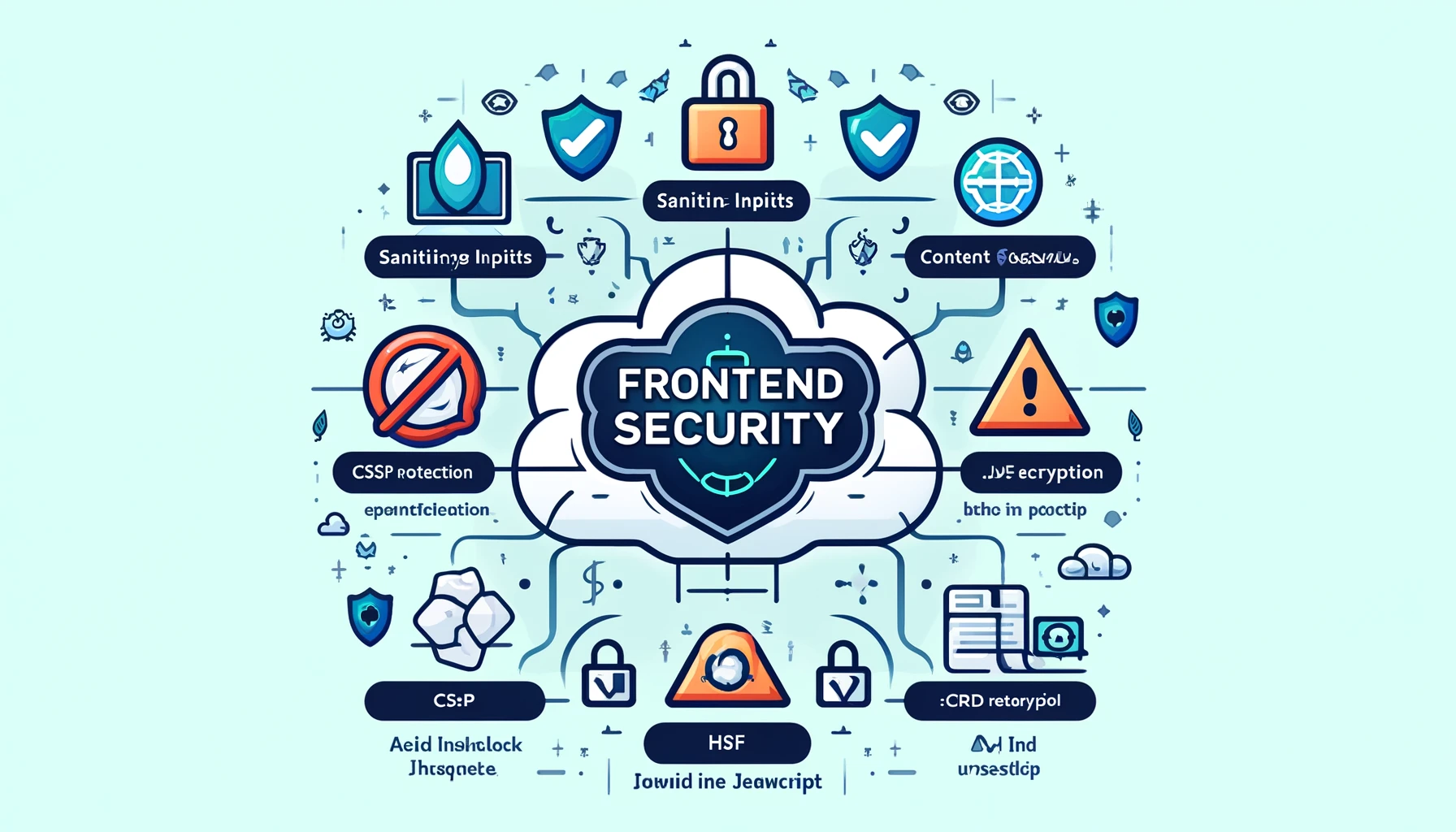
Now, to make your MERN stack as secure as possible, you’ll want to use the correct tools and libraries that can appropriately help you implement best practices, automate security functions, and monitor your app for vulnerabilities.
Here is a brief overview of a few tools and important libraries that can help in making your MERN application more secure:
- Helmet: Helmet is a security middleware for Express.js that sets various HTTP headers on an application. It secures an app by setting proper CSP, XSS protection, and HSTS headers, which meant protection from most common web vulnerabilities. Helmet can easily be used in an Express server to improve security.
- Bcrypt: Bcrypt is an established and widely adopted library for hashing passwords. Storing plain text passwords is an awful security threat, but with bcrypt, you get a safe way to salt a password before saving to the database, which is quite important. It is a widely used assertion in Node.js applications to support the storage of user passwords.
- Passport.js: Passport.js is an authentication middleware for Node.js. The strategies here are incremental: OAuth, JWT, and Local. It makes it very easy to implement in your MERN stack application but still guarantees no unauthorized person can access your resources.
- Joi: Joi is an amazing schema description language and data validation framework for JavaScript. It allows you to describe and define what kind of data is in your application and then validate the end user’s input for any specified data against this schema. With Joi, it’s close to impossible to make injection attacks, therefore ensuring that all data processed by the application is in the required format.
- OWASP ZAP: The OWASP Zed Attack Proxy (ZAP) is a freely available tool for vulnerabilities found in web applications. It can be automated for scalability in scans or actively used manually in an active approach to complete testing for potential security issues in a MERN stack application. Proactiveness in security matters can be further maintained by running ZAP on a regular basis.
- CSURF: CSURF is a middleware for Express.js used to provide protection against attacks from cross-site request forgeries. It is used to generate and verify the CSRF tokens such that all the state change requests are valid and not forged by anyone.
- Dotenv: Dotenv is a zero-dependency module that loads environment variables from a .env file into process.env when a Node.js application starts up. Sensitive configuration data, such as API keys and database credentials, is taken care of securely and never leaks to your codebase.
We are a group of developers who use these tools and libraries to make MERN stack applications that are secure. Security experts at DM WebSoft LLP seamlessly integrate these solutions to ensure all-inclusive protection for your application while ensuring that all the backend and frontend components of your application are fortified. Add them to your working process and enrich the quality of your MERN stack application by miles.
We will discuss in the upcoming section how DM WebSoft LLP can be of help in securing your applications and share some of our competency-related case studies for the implementation of some effective security solutions.
Conclusion

It’s a must: not just due to technical requirements in one’s mind but as a critical part of building trust with your users. Extremely powerful, as we’ve seen during the course of this comprehensive guide, for the development of dynamic, scalable web applications—all thanks to the MERN stack: MongoDB, Express.js, React, and Node.js. But with great web powers comes great web responsibility. An application has to be secured against the ever-growing landscape of cyber threats.
Learn about the generic security vulnerabilities in MERN stack applications: injection attacks, cross-site scripting, cross-site request forgery, and broken authentication. Help you to take the countermeasures in protecting from those risks. Best practices include implementation in such a manner that it follows secure coding standards, use of environment variables, strong authentication and authorization, and security against SQL and NoSQL injections, with frequent security audits.
Security can be greatly increased in an application by properly using tools and libraries. There are a few tools: Helmet, for setting HTTP headers; Bcrypt, for password hashing; Passport.js, which is majorly for authenticating a user; Joi, for data validation; OWASP ZAP, for scanning vulnerabilities; CSURF, for protection from CSRF attacks; and Dotenv, for management of environment variables.
DM WebSoft LLP is committed to the security of your MERN stack applications. Our team of experts is highly experienced in practicing such protocols and in using these tools to ensure your application continues to be robust against potential threats. We perform rigorous security assessments by highlighting insight areas for improvement and constant application and data security. With a partnership with DM WebSoft LLP, you can tap our expertise to architect and deliver web applications that are secure, robust, and high-performance. Our comprehensive approach to web application security means fortification at every layer, meaning peace of mind for you and freedom from the concerns of delivering a great user experience.
In conclusion, making a MERN stack application secure is not a one-step but a multi-approach process with best practices, tools, and expert guidance. Be it a developer who already had experience within MERN stack or a developer just in the learning phase, knowledge and resources are at his disposal to secure the application from today’s rising security threats. So, trust DM WebSoft LLP on your way through this unwinding and complex landscape, and set your web applications on a path guided to be secure and resilient to attain success.
We are really thankful to you for reading the guide. Hopefully, this was insightful and actionable for you. Do feel free to ask questions and contact us if you need help regarding anything at any time at DM WebSoft LLP. Together, let us build secure and successful MERN stack applications that withstand the test of time.
The MERN stack is a popular web development framework that includes MongoDB, Express.js, React, and Node.js, providing a full-stack JavaScript solution for building dynamic web applications.
Common vulnerabilities include injection attacks, cross-site scripting (XSS), cross-site request forgery (CSRF), and broken authentication and session management.
Tools like Helmet, Bcrypt, Passport.js, Joi, OWASP ZAP, CSURF, and Dotenv are essential for enhancing the security of MERN stack applications.
DM WebSoft LLP offers expert services including security audits, implementation of best practices, and continuous monitoring to ensure your MERN stack application is secure and resilient against threats.
Get Started Now !
What’s the Process ?
Request a Call
Consultation Meeting
Crafting a Tailored Proposal
Get Started Now !
Real Stories, Real Results. Discover What Our Clients Say

Working with DM WebSoft LLP was a game-changer for our business. Their technical prowess and innovative solutions transformed our online presence. A highly recommended web development agency with a stellar track record.

We are thrilled with the results DM WebSoft LLP delivered. Their deep understanding of web development coupled with years of expertise ensured a seamless and visually stunning website. True professionals!

In a digital age where first impressions matter, DM WebSoft LLP crafted a website that speaks volumes. The team’s attention to detail and commitment to quality set them apart. Thank you for making our vision a reality.

DM WebSoft LLP’s team demonstrated unparalleled expertise. Their ability to navigate complex technical challenges with ease is truly commendable. Choosing them for our web development needs was the best decision.

Exceptional service, unmatched skills! DM WebSoft LLP stands out as a leading web development agency. Their collaborative approach and commitment to excellence make them our go-to partner for all things web-related.

DM WebSoft LLP turned our ideas into a digital masterpiece. The seamless communication and timely delivery of our project showcased their professionalism. Highly impressed with the level of creativity and skill.

Our experience with DM WebSoft LLP was nothing short of amazing. From concept to execution, their team provided top-notch web development services. A reliable partner for businesses looking to elevate their online presence.

DM WebSoft LLP’s team of tech experts is second to none. Their wealth of experience reflects in the quality of their work. Our website not only meets but exceeds industry standards, thanks to their dedication.

Choosing DM WebSoft LLP was the best investment for our web development needs. Their team’s proficiency, coupled with a customer-centric approach, made the entire process smooth and enjoyable. A pleasure to work with!



